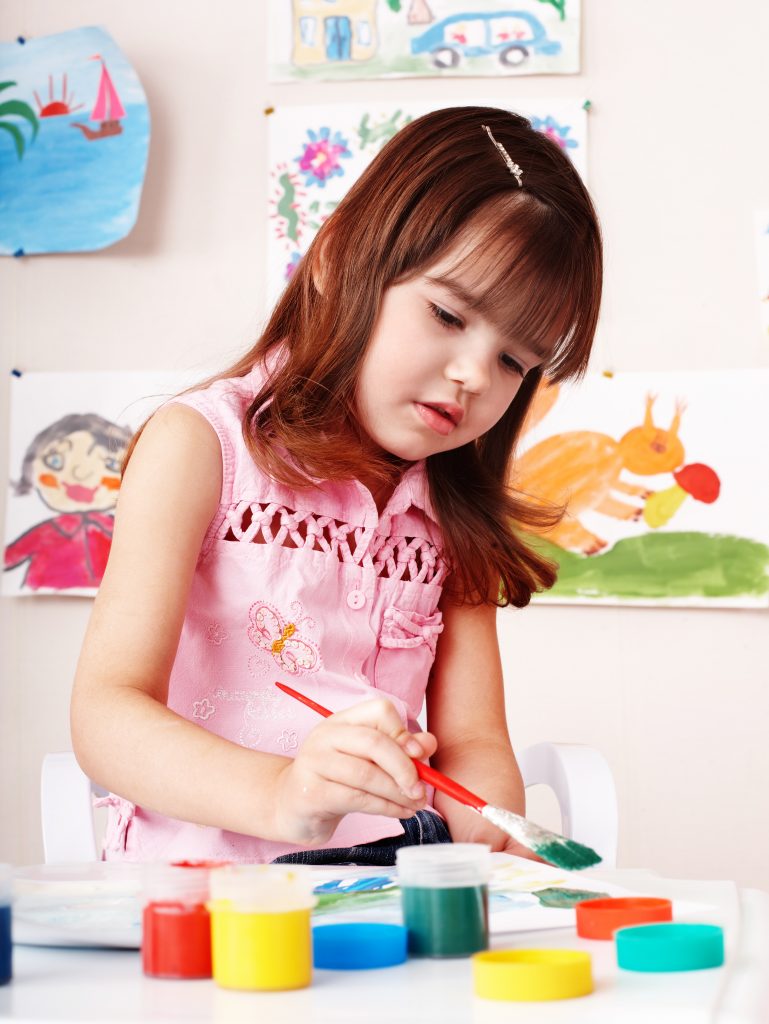- Close



How do you motivate your child to be creative?
When your children are still young, what are some things you can do to encourage them to enjoy childhood and utilize their creativity instead of turning to a device to provide all their entertainment?
First, naturally limit use of electronic devices to fill times of boredom.
A quick Google search of “the value of boredom” revealed:
- How Being Bored Out of Your Mind Makes You More Creative,
- The Surprising Benefits of Boredom, and
- The Scientific Benefits of Being Bored.
Why is it that we have lost the love of boredom? Where do good ideas come from? Being bored. Making sure that we don’t hand our child a device or allow them to flip on the television or computer every time they claim “I’m bored,” is a huge step toward helping them develop skills that allow them to seek alternatives to electronics.
Setting up stations or areas where your child can go when they are bored, can encourage creative play

A Dress-Up Station
Fill a bin with open-ended dress-up ideas. Old clothes from your closet, Grandma’s or Goodwill is a great start. Look for Halloween costumes on sale in the winter. Scarves, costume jewelry, and even large fabric remnants can inspire your little one to get into character and go on adventures. Accessories such as shoes and sunglasses also add a fun touch. Don’t forget a mirror so they can see how great they look. Dress-up can result in hours of pretending, dance events, and creative character play.
A Building Station
A tub with building supplies provides an opportunity for trial and error and figuring out the best way to create a project. Of course, Legos are great but so are other building materials. A visit to a construction site dumpster (with permission) or the local home improvement store can yield endless pieces for modular play. Various size pieces of PVC pipe and fittings, boards (remove any nails or splinters), and other building materials make for fort building paradise. Add a few sheets from a yard sale and your children may want to spend the night in their new creation.


An Arts & Crafts Station
Another storage tub could be dedicated to arts and crafts supplies. Stock up when school supplies are plentiful and add paints and paint brushes, fabric scraps and embroidery thread, glue and some construction paper, old magazines, and a couple of T-shirt’ for smocks. Your artistic child will be content for hours creating a masterpiece for your fridge.
As with any activity for young children, you will need to set parameters on where they can spread out their creative supplies and how they will need to clean them up and return them to the storage tub. Eventually they will be able to independently choose activities, rather than always going to a device for entertainment.
By offering this unstructured time, think of the opportunities you are providing for your child. They are practicing skills that use creativity, imagination, and innovation. So next time your youngster starts to whine, instead of handing over the iPad, reach for an activity tub to inspire them
Finding the right daycare for your child can be like finding the right spouse: sometimes you have to date a few frogs until you find a prince. All daycares talk a good talk and boast about how great they are at your initial walk-through, but not all deliver what they promise.
I had to take my kids to six different daycares and preschools to find the right fit for my family. Hopefully you can learn in 5 minutes what took me 5 years to figure out through trial-and-error what really should be considered a great daycare for your children.
Here are 5 key signs of a good daycare:
- A low teacher/child ratio – The most important aspect when considering child care for your infant or toddler is that age 0-3 are the absolute most important developmental years of your child’s life. These are the “make it or break it” years. If your child receives adequate nurturing, physical touch, healthy nutrition, exercise, love and respect during these years, she will avoid a plethora of physical, mental and emotional obstacles for the years to come. Unfortunately, the majority of daycares for infants and toddlers have such an unbalanced teacher/child ratio that it is impossible for them to give any child the nurturing that they need to thrive. Before your child is walking, try to find a 1:1 or 1:2 ratio (possibly a nanny or family member). Once they are walking, look for a maximum of a 1:6 ratio.
- Healthy meals and snacks – What your child eats is just as important as them receiving proper nurturing and love. One daycare my daughter attended was a “big name” daycare, but they served French toast covered in butter and syrup for breakfast, steak fingers for lunch and cookies for snacks. The nail in the coffin was the fact that they prohibited parents from packing healthy lunches for their kids. Either my kids ate the junk food they served or they didn’t eat at all. You should always be able to bring your own meals, snacks and drinks for your child.
- Is your daycare truly a school where your children are learning, or is it merely a “storage unit”? Just because the word “school” is in the name of your daycare, doesn’t mean squat these days. Ask the teachers daily what was taught to your kids, what books were read, worksheets completed, artwork, etc…
- Adequate daily exercise – the best daycares know that adequate exercise in children results in more attentive, better behaved and less hyper children. The best schools will provide outdoor physical activities morning, noon and afternoon (3 times per day).
- Positive discipline – Every school has their own individual philosophy on how they handle kids who misbehave. The best schools will discipline out of love and respect and will never use corporal punishment or inappropriate language with your child.
You might be thinking “Finding a school with a low teacher/student ratio, healthy food options, adequate exercise, very educational and that practices positive discipline is too good to be true. This school cannot exist!” Well, it took me six tries, a lot of shopping around and a lot of frustration, but I did find a lovely preschool for my children that has met these requirements.
Important questions to ask any child care provider before you enroll your child:
- Are you licensed?
- Do you have insurance for accidents?
- What do you serve for meals, snacks and drinks?
- Can I bring outside food for my child?
- How often do the kids play outside?
- What is the teacher/child ratio?
- How do you discipline misbehavior?
- Can you show me some of the class work some of the current students have completed?
- Can my child come for 2 hours this Friday to check out your school?
- Can I drop in any time to observe the class?
Here are 4 traps to avoid when daycare shopping:
- Don’t take another parent’s word on how good a school is. What works (and is important) to your family may not be the same standards for your dearest neighbor next door.
- Just because a daycare center is accredited, that doesn’t always mean it has good leadership, good teachers or has high standards for nutrition or daily exercise.
- Just because a daycare center is a “household name” or nationwide chain, doesn’t mean it’s good.
- Just because a daycare center is new or has fancy decor, doesn’t mean it’s better than the older schools with more modest trimmings.
A few more tips:
- Use your gut instinct. If your gut says “There is something about this place I just don’t like” then listen to this instinct and take action.
- Pop in at random times to see what your daycare is really doing when parents aren’t around. Most schools turn on the charm at key drop-off and pick-up times, but if you swing by after your lunch break you might see a different picture (same rule of thumb is for nannies and babysitters).
- Avoid schools who have pricey “enrollment fees” (no more than $150). The reason schools sometimes have high enrollment fees is so three months into your stay at this school when you realize the school has over-promised and under-delivered, you will say to yourself, “I can’t change schools because I just paid that hefty non-refundable fee.” This is the school’s way of keeping you around.
Keep in mind that your child may spend more time at daycare than any other place in the world during the most important developmental times of his life. Choose wisely. Be willing to pay a bit more if the care is substantially better. And don’t hesitate for a second if you see or sense that your child is not receiving the proper care she needs and deserves.
You probably already know what sleep is for. You know that your brain is actually just as active during sleep as it is when you’re awake, organizing what was learned during the day and laying down memories. The purpose of sleep is to minimize the need for activity so the important brain work can be accomplished. It’s sort of like what happens after-hours at your local grocery store. The shelves get rearranged, stock is replenished, improvements are made – things that couldn’t happen as well when the place is full of customers.
So it’s important that your children – and you! – get enough sleep at night. But now a new study indicates that for children, at least, daytime naps serve the same function. Preschoolers who nap know more than preschoolers who don’t.
Researchers at the University of Massachusetts Amherst taught children to play a game like “Memory” in which they needed to remember the location of different pictures. They played the game in the morning, Then, during their regular naptime, some children were encouraged to sleep while others were kept awake. Nappers typically slept for 77 minutes. In the afternoon, they played the game again and again the next day. Children who napped remembered significantly more of the Memory game picture placements than children who didn’t, both immediately and on the following day.
According to lead researcher, Rebecca Spencer, “Our study shows that naps help the kids better remember what they are learning in preschool…When they miss a nap, the child cannot recover this benefit of sleep with their overnight sleep. It seems that there is an additional benefit of having the sleep occur in close proximity to the learning.”
A follow-up study using brain scans confirmed that during naps, “sleep spindles” increase. These indicators of brain activity are associated with formation of new learning.
What does this mean for us?
- Make certain your preschool child gets sufficient sleep at night and also during naps. Don’t hurry to eliminate naps.
- Don’t push your child’s preschool to replace naptime with more academic time. Insist that your child who takes naps at home be allowed to nap at school.
- Counter administrative efforts to eliminate naps, increase homework, and shorten recess. Downtime is needed for learning to happen.
Spencer says, “Children should not only be given the opportunity, they should be encouraged to sleep by creating an environment which supports sleep.” Do that for your child.
© 2013, Patricia Nan Anderson. All rights reserved. This material may not be published, broadcast, rewritten, or redistributed. Ask for Dr. Anderson’s new book, Developmentally Appropriate Parenting, at your favorite bookstore.


